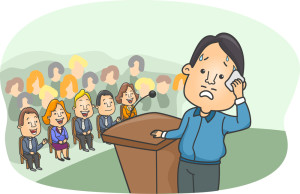Many years ago, while speaking to a group of Thai delegates on a trip through the Rockies, I told my favorite grizzly joke. The interpreter spent 3 minutes translating my hilarious joke, where upon the group gazed at me with an eerie collective silence. Their facial expressions seemed to be saying, “Is this man mentally deranged?” The interpreter furtively whispered in my ear, “They  don’t understand. I’ll tell them a funny joke.” And so ended my first foray into trans-cultural humor.
don’t understand. I’ll tell them a funny joke.” And so ended my first foray into trans-cultural humor.
Practicing “safe humor” is the golden rule of adding humor to any presentation. When speaking to audiences of other nationalities and cultures, the rule becomes doubly important. In fact, the Foreign Service Journal magazine advises: “Next to treason, making an inappropriate joke may rank as the 2nd most taboo practice in diplomacy.” When it comes to professional speaking, it could well be the number one taboo.
Different cultures have different styles of humor, so be prepared before treading blindly into uncharted humor seas. Japanese audiences don’t enjoy any sort of humor that directs attention towards or embarrasses another person. British humor often focuses on slapstick and farce. The Swiss have a very gentle, understated approach to humor. Subtle differences can even appear within a country. Germans from southern regions are typically more gregarious than their more stoic northern counterparts.
Also be aware of how different nationalities react to humor. Japanese audiences rarely laugh out loud. Malaysians sometimes laugh to mask their anger (probably not the kind of laughs you should be going for). And in some eastern European countries where comedy clubs are opening for the first time, comedians are discovering that 20 minutes of silence doesn’t necessarily mean they bombed. Some cultures simply don’t laugh out loud in public.
Here are a few rules of the road for practicing safe humor overseas
Avoid jokes, especially ones involving wordplay or puns. Focus instead on humorous stories that have a universal appeal.
Avoid any sort of humor that pokes fun at their country or customs, instead look for humor from your home country and customs.
Give any political and religious humor and wide berth. As in, mage-wide. As in, not even with a 476-foot pole.
 Avoid sarcasm at all costs, it rarely translates well across other languages or cultures.
Avoid sarcasm at all costs, it rarely translates well across other languages or cultures.
Practice the number one rule of safe humor – laugh at yourself first and foremost. Poke fun at some of your challenges or misunderstandings you experienced adapting to their country or language.
Discuss any concerns about humor with the organizers beforehand. Ask your hosts what works well and what doesn’t. Ask for examples you might be able to use safely.
If you are working with a simultaneous translator, discuss concerns with them beforehand as well.
Watch your pacing: if it’s a different language (or even just a regional accent) you will need to slow down so they understand you, pause more, and leave more time for the laughter to toll out through the audience.
Visual humor involving funny props, costume parts, exaggerated body language and facial expressions can usually work well universally.
If you want to instantly win over any audience, learn some of the local lingo and a few key phrases in their language, even if the country speaks the same language as you.
Read up on the humor customs of the country you’ll be speaking in. There’s a wealth of information on the internet so do your homework beforehand.
Now having cautioned you (and perhaps scaring the humor right out of you), do keep in mind that laughter truly is a universal language. So the next time you speak internationally pack along your sense of humor – just make sure it suits the audience…and fits inside your luggage.
Michael Kerr is a Hall of Fame speaker and the author of 8 books, including The Jerk-Free Workplace and The Humor Advantage: Why Some Businesses are Laughing All the Way to the Bank. www.mikekerr.com


